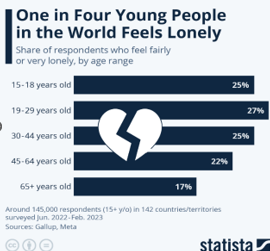Loneliness in Young People
Loneliness is different to everyone. Some people are longing for a partner or a close friend, some people are having difficulties to find any meaningful connections, whilst others feel a general sense of disconnection from the world. To tackle loneliness it is important to understand it first.
Sandra Natus
6/10/202521 min read
Welcome to my Blog!
It is my mission to help you navigate the challenges of loneliness and build meaningful connections. But loneliness comes along in many forms and nuances. With my blogs about loneliness I want to reflect on different aspects of loneliness to provide more insight and create understanding.

Welcome to my Blog!
It is my mission to help you navigate the challenges of loneliness and build meaningful connections. Whether you're feeling isolated due to life changes, work conditions/stress, or simply the fast pace of modern life, you're not alone. Let's embark on this journey together.
The Shift in Loneliness Trends to the Younger Generations
In today's hyper-connected world, feeling lonely despite being surrounded by people—both online and offline—is all too common. In fact, 60%-70% of young people report experiencing this disconnect. Loneliness, as described by Perlman and Peplau (1981), is the gap between the relationships we crave and those we actually have—a struggle many people can relate to."
In today’s blog, I’ll share my thoughts on the loneliness epidemic among younger generations. I’ll explore what has changed and what might be missing, while offering practical tips for parents, caregivers, and young people to foster meaningful connections. My ideas are grounded in both personal observations and insights from research.
A Sad New Trend
While loneliness has long been associated with older generations, recent evidence points to a surprising shift—young people, aged 15 to 25, are now becoming the loneliest demographic in many Western societies.
In the past, older people were often thought to be the group most affected by loneliness, due to shifts towards smaller, nuclear families, naturally declining health and mobility limiting connectivity, and the loss of close relationships like lifelong partners or friends their own age taking its toll." This depiction of loneliness among the elderly has been reinforced by media narratives for decades, shaping public perception.
But the trend has shifted. According to Headspace’s National Youth Mental Health Survey (2022), 62% of young Australians often or sometimes feel left out, 60% report lacking companionship, and 58% feel isolated from others. Similarly, a global study by Gallup and Meta (2022/23) found that 25% of individuals aged 15 to 29 feel either very lonely or fairly lonely."
As the mother of two young adults this change has admittedly hit me with some surprise. How is this possible? What has led to this shift? Thinking back to my own youth and young adolescence I remember that youth and young adolescence was the time when meeting and connecting with new people, making new friends and finding a partner was somewhat easier compared to later stages in my life.
So, What Has Changed?
Growing up is a universal experience of having to learn to stand on their own feet, finding a place in life, and building a social network of people who share their values and beliefs. While everyone’s personal journey is shaped by individual and cultural differences, there are also shared generational experiences that unite us during this transitional phase from childhood to adulthood. It is a time to discover who we are, where we belong, and how we fit into the world.
versus
So, what has changed? While the struggles of adolescence are timeless, the way they are experienced has shifted dramatically across generations.
The 24/7 Conflict Cycle: How Endless Scrolling and Unrealistic Ideals Exhaust Young People
Reflecting on my own youth in the 1970s and 1980s, I remember how daunting it all felt. As a naturally unconfident child, the transition to adulthood was complicated, but we navigated these challenges together as a group. My generation built stronger personal connections because we faced our differences head-on, without the option to block, delete or divert to virtual world. For better or worse, we had no choice but to work things out as a group if we wanted to stay in touch with others.
However, the conflicts and confrontations that arose from relationships were largely confined to specific contexts. School conflicts stayed mostly at school, disputes from other places remained there, and sibling tensions were mostly limited to family time. In contrast, social media has blurred the boundaries and conflicts can follow young people everywhere at any time. With the prevalence of technology and social media, there is no to little downtime to process these challenges or take a break from them.
Media’s portrayal of an ideal life was confined to occasional magazines, movies, or TV shows, and their influence was far less pervasive than the social media saturation young people face today. While there was pressure to emulate models or idols, it was nothing compared to the constant exposure to curated perfection that now dominates daily life. The inevitability of human imperfection and the need to belong into this ‘real’ world made us more accepting of our own quirks and those of others.
In essence, my generation's immersion in the real world—with all its quirks and imperfections—taught us to accept people holistically. This fostered a more realistic and forgiving view of both our own limitations and those of others. In contrast, the constant nature of modern conflicts and the omnipresence of an unrealistic virtual world contribute to emotional and mental fatigue.
The Shift in the Upbringing of Children to More Self-Centredness.
Another factor complicating young people's ability to understand their true selves is the rise of overly idealized approaches to upbringing and education since the 1990s, which I believe often overlooked the realities of human imperfection.
I firmly believe that highlighting a person’s strengths, particularly in developing young minds, is essential for nurturing confident and healthy adults. However, while the emphasis on strengths is invaluable, its application in modern upbringing sometimes lacks balance. I’ve noticed that feedback given to children today often appears to avoid constructive criticism for fear of upsetting them—or their parents and caregivers. At times, I think the exaggerated and unrealistic feedback given to children can be confusing for them.
Praising children with exaggerated compliments simply for meeting developmental or educational milestones may feel encouraging in the moment, but it can also create unrealistic expectations in young minds. Growing up in 1970s and 1980s Germany, awards were rare, and being 'average' was seen as the norm, not as an insult. This approach, though not without flaws, fostered more grounded expectations toward us and others. I am not suggesting that this was a better method, as both extremes have their drawbacks, but providing children with a healthy balance of feedback is crucial for fostering a positive sense of self. For feedback to be meaningful, it must also include an honest recognition of shortcomings, which are a natural part of human existence. Striking this balance is never easy—every parent, caregiver, teacher, etc. understands this challenge. However, limiting feedback to only positive traits, overstating achievements, or reframing failures as purely positive experiences can sometimes overlook the value of honest reflection.
The Pressure to Be Exceptional: How Unrealistic Standards Distort Connection"
In today’s culture, being 'normal' is often seen as a flaw rather than a shared experience. This unrealistic mindset undermines the ability to value authentic relationships. Accepting ourselves and others holistically is the foundation for deep, meaningful connections. Without this grounding in self-acceptance, we cannot truly give or experience love.
Believing that we—or others—must be perfect or exceptional to be worthy of connection limits our ability to genuinely understand and embrace relationships. Conflicts also become harder to resolve when we lack a mature acceptance of human imperfections—both our own and those of others. This idealistic perspective keeps young people tethered to unrealistic expectations, making authentic connection increasingly difficult. In my conversations with young people, I often hear how exhausting they find their social lives. Socializing feels like an endless race where they must meet countless idealized standards, leaving little room for genuine human experiences, imperfections, or even simple, natural interactions. As a result, socializing often makes them feel lonelier rather than more connected.
The Competitive Shift in Recreation: Losing Sight of Community Connections
I observed this trend in many sports-based activities for children and young people throughout the 2000s. When my daughter joined various sports purely for enjoyment, it quickly became clear that the emphasis on competitive performance overshadowed the inclusive aspects of participation. Trainers, often focused on identifying future champions, paid little attention to her once they realized she wasn’t interested in competing. While I understand that this trend was largely driven by parental expectations, the singular focus on performance diminished opportunities for children like her to experience the social and communal benefits of engaging in sports simply for fun and connection.
Over time, parenting and community priorities have increasingly cantered on individual achievement—likely a response to the pressures of an increasingly competitive world. While this emphasis has fostered dedication and excellence, it has also unintentionally deprioritized the broader social value of community connections. Once again, the notion that one must stand out to feel seen is overshadowing the fundamental role of recreational activities in fostering meaningful interactions. I can’t help but feel that something important has been lost.
Social Media
Recently, I watched an insightful program on German television titled "Generation Angst" (Generation Fear), which explored the profound effects of social media on young people. While the link between social media and mental health issues remains somewhat unclear, the program shed light on the alarming rise in mental health challenges amongst younger generations since the widespread adoption of social media.
Social media influences young minds both directly and indirectly. Its direct impact arises from how news is presented, particularly on social platforms, which shapes emotions and behaviour. In a world of constant notifications, social media often seeks to capture attention through sensationalism, catastrophizing, and exploiting divisions in opinions. As a result, the relentless exposure to alarming content amplifies fears and resentments across all age groups. However, for young minds lacking the life experience to process such information with perspective, the effects are even more pronounced. This creates a distorted view of the world as unstable, untrustworthy, resentful, and hostile. Different opinions are perceived as existential threats, and this negativity is delivered to them for hours each day without filters or safeguards.
Indirect effects arise from the shifts in socialization patterns among children and teenagers. Traditional community-based interactions have largely been replaced by technology, particularly by the use of social media platforms. Although social media was designed to foster connections, it often achieves the opposite. Young people, eager to form relationships, turn to social media to connect. Yet, these connections only hold true value when they translate into real-world actions like meeting people face-to-face and engaging in meaningful relationships with real people with all their joys and complexities.
Many young individuals find themselves immersed in a virtual world that imposes unrealistic expectations on both themselves, and others. They are caught in an endless cycle of ‘befriending,’ ‘liking,’ ‘posting,’ ‘muting,’ and ‘unfriending’—alongside hours of mindless scrolling. For many, online interactions have begun to replace real social experiences. Yet, relying on social media to build connections is akin to living on junk food—it may offer temporary gratification, but it lacks genuine substance. Over time, this dependence leads to emotional malnutrition, leaving individuals longing for deeper, more fulfilling relationships. The powerful influence of social media, especially on young people, often blinds them to its crippling effects on social development and real-world interactions. As a result, an alarming loneliness crisis continues to unfold.
Conclusion
The cultural shift over the past few decades—from a more communal, grounded approach to life toward an increasingly performance-driven and idealized existence—has reshaped the way young people experience relationships, self-worth, and socialization. Social media, competitive pressures, and unrealistic expectations have fostered an environment where connection feels transactional, and personal value is measured by external validation.
In this new landscape, exhaustion and loneliness have become unintended consequences of a world that rewards perfection over authenticity. Young people are continuously exposed to conflicts that never seem to rest, burdened by the pressure to stand out, and left navigating a digital world that often fails to provide true human connection.
I think, it’s essential to recognize that assigning blame for the issue of loneliness is both unhelpful and counterproductive. Young people should not be faulted for this dynamic, as many have not had the opportunity to experience how a stable social network relies on mutual give-and-take, even when it requires effort or feels inconvenient. Likewise, parents and caregivers generally act with the best intentions, striving to do what they believe is best for their children. However, as humans, we are not immune to making mistakes despite our earnest efforts.
But despite these challenges, there is still an opportunity to reclaim the depth and meaning of genuine interaction. Prioritizing community over competition, embracing imperfection instead of avoiding it, and fostering social experiences beyond the digital sphere can help restore a sense of belonging. True connection is not built on fleeting online exchanges or unattainable ideals—it thrives in real relationships, shared experiences, and the acceptance of others as they truly are.
What truly matters is learning from our experiences and shifting the focus toward solutions and a path forward, because loneliness is not an irreversible fate. By fostering mutual effort and placing renewed importance on genuine connection, we can tackle loneliness and create a future built on genuine social interactions, compassion and community. where people—especially young people—can feel valued, heard, and genuinely connected without the weight of unrealistic expectations.
First Steps to Feeling More Connected
Loneliness is a deeply personal experience, unique to each individual. As a result, there is no single, universal solution to overcoming it. However, both parents/caregivers and young people themselves can take meaningful steps toward fostering connection. While these steps may not provide an instant solution, they can serve as an important starting point.
Parents/Caregivers
Encourage participation in local activities and volunteering to build connections.
Prioritize quality family time and open conversations.
Set tech boundaries to promote offline interactions.
Support social skill development through empathy and conflict resolution.
Teach responsible internet use and discuss online risks.
Older Teens & Young Adults
Reflect on strengths, values, and boundaries in relationships.
Build authentic connections with supportive people.
Foster mutual, balanced relationships through active listening.
Continuously develop social adaptability and relationship awareness.
Manage challenges and seek guidance when needed.
How Loneliness Coaching Can Help You
Many people feel ashamed of their loneliness and unfortunately, it is this shame that is blocking their way to more connection. But let me assure you—there is no shame in it. Almost everyone experiences loneliness at some point in their lives; it’s simply a part of the human experience.
“Loneliness does not define you. You are not broken; you are growing, and I am here to support you in that growth.”
As a Loneliness Coach, I provide a safe and compassionate space for you to explore your feelings and take manageable steps toward meaningful connection. Together, we will uncover the roadblocks that keep you stuck and create a path tailored to your personal journey.
If you're ready to take that first step, book a free introductory call or email me on sandra.natus@thedoorahead.com.au. And if you know someone who might benefit from these insights, feel free to share my blogs on loneliness with them.
My next blog about loneliness
In my upcoming blog I will explore the experience of loneliness with a special focus on young men.
Your Loneliness Coach,
Sandra
PS:
Stay safe!
Your safety and well-being are paramount. While loneliness can be a challenging experience, it can also become the path to a deeply fulfilling and enjoyable life. Everyone experiences loneliness differently. For some people, it may result in persistent feelings of hopelessness, anxiety, suicidal thoughts, or reliance on addictive behaviours. If this resonates with you, please take it seriously and seek help from a mental health professional. Coaching is a valuable tool, but it is not intended to treat mental health conditions. Ensuring your mental health safety is the first step before life coaching can be effective.
















Loneliness in Young People






The Shift in Loneliness Trends to the
younger Generations
In today's hyper-connected world, feeling lonely despite being surrounded by people—both online and offline—is all too common. In fact, 60%-70% of young people report experiencing this disconnect. Loneliness, as described by Perlman and Peplau (1981), is the gap between the relationships we crave and those we actually have—a struggle many people can relate to."
In today’s blog, I’ll share my thoughts on the loneliness epidemic among younger generations. I’ll explore what has changed and what might be missing, while offering practical tips for parents, caregivers, and young people to foster meaningful connections. My ideas are grounded in both personal observations and insights from research.
A Sad New Trend
While loneliness has long been associated with older generations, recent evidence points to a surprising shift—young people, aged 15 to 25, are now becoming the loneliest demographic in many Western societies.
In the past, older people were often thought to be the group most affected by loneliness, due to shifts towards smaller, nuclear families, naturally declining health and mobility limiting connectivity, and the loss of close relationships like lifelong partners or friends their own age taking its toll." This depiction of loneliness among the elderly has been reinforced by media narratives for decades, shaping public perception.
But the trend has shifted. According to Headspace’s National Youth Mental Health Survey (2022), 62% of young Australians often or sometimes feel left out, 60% report lacking companionship, and 58% feel isolated from others. Similarly, a global study by Gallup and Meta (2022/23) found that 25% of individuals aged 15 to 29 feel either very lonely or fairly lonely."
As the mother of two young adults this change has admittedly hit me with some surprise. How is this possible? What has led to this shift? Thinking back to my own youth and young adolescence I remember that youth and young adolescence was the time when meeting and connecting with new people, making new friends and finding a partner was somewhat easier compared to later stages in my life.
So, What Has Changed?
Growing up is a universal experience of having to learn to stand on their own feet, finding a place in life, and building a social network of people who share their values and beliefs. While everyone’s personal journey is shaped by individual and cultural differences, there are also shared generational experiences that unite us during this transitional phase from childhood to adulthood. It is a time to discover who we are, where we belong, and how we fit into the world.
So, what has changed? While the struggles of adolescence are timeless, the way they are experienced has shifted dramatically across generations.
The 24/7 Conflict Cycle: How Endless Scrolling and Unrealistic Ideals Exhaust Young People
Reflecting on my own youth in the 1970s and 1980s, I remember how daunting it all felt. As a naturally unconfident child, the transition to adulthood was complicated, but we navigated these challenges together as a group. My generation built stronger personal connections because we faced our differences head-on, without the option to block, delete or divert to virtual world. For better or worse, we had no choice but to work things out as a group if we wanted to stay in touch with others.
However, the conflicts and confrontations that arose from relationships were largely confined to specific contexts. School conflicts stayed mostly at school, disputes from other places remained there, and sibling tensions were mostly limited to family time. In contrast, social media has blurred the boundaries and conflicts can follow young people everywhere at any time. With the prevalence of technology and social media, there is no to little downtime to process these challenges or take a break from them.
Media’s portrayal of an ideal life was confined to occasional magazines, movies, or TV shows, and their influence was far less pervasive than the social media saturation young people face today. While there was pressure to emulate models or idols, it was nothing compared to the constant exposure to curated perfection that now dominates daily life. The inevitability of human imperfection and the need to belong into this ‘real’ world made us more accepting of our own quirks and those of others.
In essence, my generation's immersion in the real world—with all its quirks and imperfections—taught us to accept people holistically. This fostered a more realistic and forgiving view of both our own limitations and those of others. In contrast, the constant nature of modern conflicts and the omnipresence of an unrealistic virtual world contribute to emotional and mental fatigue.
The Shift in the Upbringing of Children to More Self-Centredness.
Another factor complicating young people's ability to understand their true selves is the rise of overly idealized approaches to upbringing and education since the 1990s, which I believe often overlooked the realities of human imperfection.
I firmly believe that highlighting a person’s strengths, particularly in developing young minds, is essential for nurturing confident and healthy adults. However, while the emphasis on strengths is invaluable, its application in modern upbringing sometimes lacks balance. I’ve noticed that feedback given to children today often appears to avoid constructive criticism for fear of upsetting them—or their parents and caregivers. At times, I think the exaggerated and unrealistic feedback given to children can be confusing for them.
Praising children with exaggerated compliments simply for meeting developmental or educational milestones may feel encouraging in the moment, but it can also create unrealistic expectations in young minds. Growing up in 1970s and 1980s Germany, awards were rare, and being 'average' was seen as the norm, not as an insult. This approach, though not without flaws, fostered more grounded expectations toward us and others. I am not suggesting that this was a better method, as both extremes have their drawbacks, but providing children with a healthy balance of feedback is crucial for fostering a positive sense of self. For feedback to be meaningful, it must also include an honest recognition of shortcomings, which are a natural part of human existence. Striking this balance is never easy—every parent, caregiver, teacher, etc. understands this challenge. However, limiting feedback to only positive traits, overstating achievements, or reframing failures as purely positive experiences can sometimes overlook the value of honest reflection.
The Pressure to Be Exceptional: How Unrealistic Standards Distort Connection"
In today’s culture, being 'normal' is often seen as a flaw rather than a shared experience. This unrealistic mindset undermines the ability to value authentic relationships. Accepting ourselves and others holistically is the foundation for deep, meaningful connections. Without this grounding in self-acceptance, we cannot truly give or experience love.
Believing that we—or others—must be perfect or exceptional to be worthy of connection limits our ability to genuinely understand and embrace relationships. Conflicts also become harder to resolve when we lack a mature acceptance of human imperfections—both our own and those of others. This idealistic perspective keeps young people tethered to unrealistic expectations, making authentic connection increasingly difficult. In my conversations with young people, I often hear how exhausting they find their social lives. Socializing feels like an endless race where they must meet countless idealized standards, leaving little room for genuine human experiences, imperfections, or even simple, natural interactions. As a result, socializing often makes them feel lonelier rather than more connected.
The Competitive Shift in Recreation: Losing Sight of Community Connections
I observed this trend in many sports-based activities for children and young people throughout the 2000s. When my daughter joined various sports purely for enjoyment, it quickly became clear that the emphasis on competitive performance overshadowed the inclusive aspects of participation. Trainers, often focused on identifying future champions, paid little attention to her once they realized she wasn’t interested in competing. While I understand that this trend was largely driven by parental expectations, the singular focus on performance diminished opportunities for children like her to experience the social and communal benefits of engaging in sports simply for fun and connection.
Over time, parenting and community priorities have increasingly cantered on individual achievement—likely a response to the pressures of an increasingly competitive world. While this emphasis has fostered dedication and excellence, it has also unintentionally deprioritized the broader social value of community connections. Once again, the notion that one must stand out to feel seen is overshadowing the fundamental role of recreational activities in fostering meaningful interactions. I can’t help but feel that something important has been lost.
Social Media
Recently, I watched an insightful program on German television titled "Generation Angst" (Generation Fear), which explored the profound effects of social media on young people. While the link between social media and mental health issues remains somewhat unclear, the program shed light on the alarming rise in mental health challenges amongst younger generations since the widespread adoption of social media.
Social media influences young minds both directly and indirectly. Its direct impact arises from how news is presented, particularly on social platforms, which shapes emotions and behaviour. In a world of constant notifications, social media often seeks to capture attention through sensationalism, catastrophizing, and exploiting divisions in opinions. As a result, the relentless exposure to alarming content amplifies fears and resentments across all age groups. However, for young minds lacking the life experience to process such information with perspective, the effects are even more pronounced. This creates a distorted view of the world as unstable, untrustworthy, resentful, and hostile. Different opinions are perceived as existential threats, and this negativity is delivered to them for hours each day without filters or safeguards.
Indirect effects arise from the shifts in socialization patterns among children and teenagers. Traditional community-based interactions have largely been replaced by technology, particularly by the use of social media platforms. Although social media was designed to foster connections, it often achieves the opposite. Young people, eager to form relationships, turn to social media to connect. Yet, these connections only hold true value when they translate into real-world actions like meeting people face-to-face and engaging in meaningful relationships with real people with all their joys and complexities.
Many young individuals find themselves immersed in a virtual world that imposes unrealistic expectations on both themselves, and others. They are caught in an endless cycle of ‘befriending,’ ‘liking,’ ‘posting,’ ‘muting,’ and ‘unfriending’—alongside hours of mindless scrolling. For many, online interactions have begun to replace real social experiences. Yet, relying on social media to build connections is akin to living on junk food—it may offer temporary gratification, but it lacks genuine substance. Over time, this dependence leads to emotional malnutrition, leaving individuals longing for deeper, more fulfilling relationships. The powerful influence of social media, especially on young people, often blinds them to its crippling effects on social development and real-world interactions. As a result, an alarming loneliness crisis continues to unfold.
Conclusion
The cultural shift over the past few decades—from a more communal, grounded approach to life toward an increasingly performance-driven and idealized existence—has reshaped the way young people experience relationships, self-worth, and socialization. Social media, competitive pressures, and unrealistic expectations have fostered an environment where connection feels transactional, and personal value is measured by external validation.
In this new landscape, exhaustion and loneliness have become unintended consequences of a world that rewards perfection over authenticity. Young people are continuously exposed to conflicts that never seem to rest, burdened by the pressure to stand out, and left navigating a digital world that often fails to provide true human connection.
I think, it’s essential to recognize that assigning blame for the issue of loneliness is both unhelpful and counterproductive. Young people should not be faulted for this dynamic, as many have not had the opportunity to experience how a stable social network relies on mutual give-and-take, even when it requires effort or feels inconvenient. Likewise, parents and caregivers generally act with the best intentions, striving to do what they believe is best for their children. However, as humans, we are not immune to making mistakes despite our earnest efforts.
But despite these challenges, there is still an opportunity to reclaim the depth and meaning of genuine interaction. Prioritizing community over competition, embracing imperfection instead of avoiding it, and fostering social experiences beyond the digital sphere can help restore a sense of belonging. True connection is not built on fleeting online exchanges or unattainable ideals—it thrives in real relationships, shared experiences, and the acceptance of others as they truly are.
What truly matters is learning from our experiences and shifting the focus toward solutions and a path forward, because loneliness is not an irreversible fate. By fostering mutual effort and placing renewed importance on genuine connection, we can tackle loneliness and create a future built on genuine social interactions, compassion and community. where people—especially young people—can feel valued, heard, and genuinely connected without the weight of unrealistic expectations.
First Steps to Feeling More Connected
Loneliness is a deeply personal experience, unique to each individual. As a result, there is no single, universal solution to overcoming it. However, both parents/caregivers and young people themselves can take meaningful steps toward fostering connection. While these steps may not provide an instant solution, they can serve as an important starting point.
Parents/Caregivers
Encourage participation in local activities and volunteering to build connections.
Prioritize quality family time and open conversations.
Set tech boundaries to promote offline interactions.
Support social skill development through empathy and conflict resolution.
Teach responsible internet use and discuss online risks.
Older Teens & Young Adults
Reflect on strengths, values, and boundaries in relationships.
Build authentic connections with supportive people.
Foster mutual, balanced relationships through active listening.
Continuously develop social adaptability and relationship awareness.
Manage challenges and seek guidance when needed.
How Loneliness Coaching Can Help You
Many people feel ashamed of their loneliness and unfortunately, it is this shame that is blocking their way to more connection. But let me assure you—there is no shame in it. Almost everyone experiences loneliness at some point in their lives; it’s simply a part of the human experience.
“Loneliness does not define you. You are not broken; you are growing, and I am here to support you in that growth.”
As a Loneliness Coach, I provide a safe and compassionate space for you to explore your feelings and take manageable steps toward meaningful connection. Together, we will uncover the roadblocks that keep you stuck and create a path tailored to your personal journey.
If you're ready to take that first step, book a free introductory call or email me on sandra.natus@thedoorahead.com.au.
And if you know someone who might benefit from these insights, feel free to share my blogs on loneliness with them.
My next blog about loneliness
In my upcoming blog I will explore the experience of loneliness with a special focus on young men.
Your Loneliness Coach,
Sandra
PS:
Stay safe!
Your safety and well-being are paramount. While loneliness can be a challenging experience, it can also become the path to a deeply fulfilling and enjoyable life. Everyone experiences loneliness differently. For some people, it may result in persistent feelings of hopelessness, anxiety, suicidal thoughts, or reliance on addictive behaviours. If this resonates with you, please take it seriously and seek help from a mental health professional. Coaching is a valuable tool, but it is not intended to treat mental health conditions. Ensuring your mental health safety is the first step before life coaching can be effective.
"Loneliness in Younger People"















